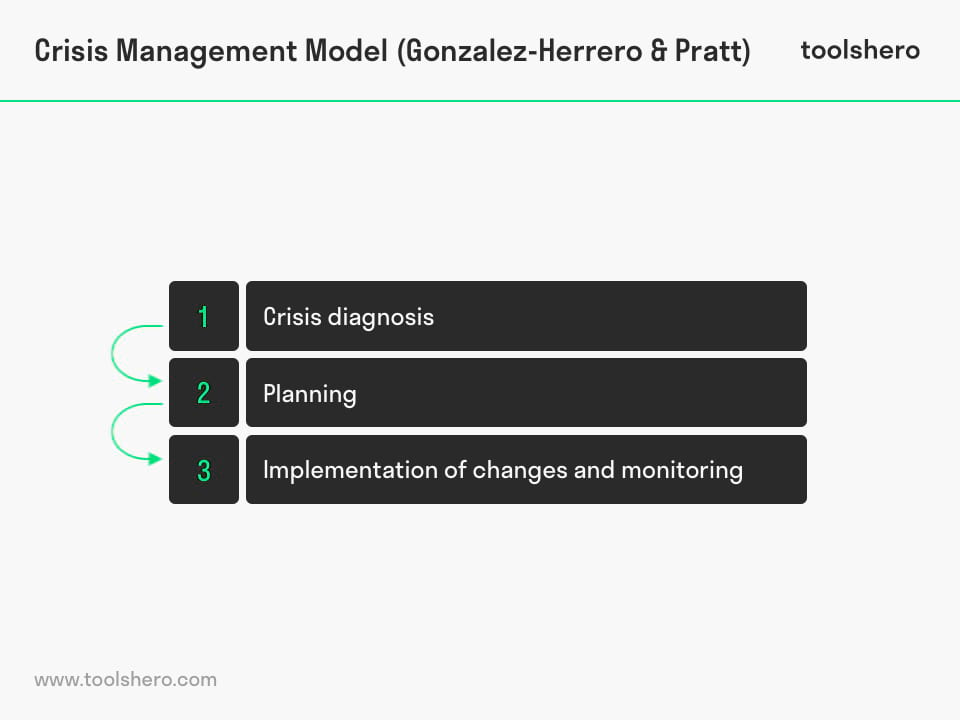Crisis Management Model

Crisis Management Model: this article provides a practical explanation of the Crisis Management Model developed by Alfonso Gonzalez-Herrero and Cornelius Pratt. After reading, you will understand the basic concepts of this powerful organizational management tool.
What is the Crisis Management Model?
Alfonso Gonzalez-Herrero and Cornelius Pratt developed a Crisis Management Model in the late 1990, in which they defined three stages within Crisis Management. In order to understand what Crisis Management is, it is first necessary to understand what a crisis is, and how it affects a company.
A crisis is an unpredictable process or event, which can cause damage with a negative impact on an organization such as: dissatisfied employees, industrial accidents, environmental problems, astute competitors, financial problems and unhappy stakeholders, such crisis can affect the whole company or part of it.
Crisis Management is the way in which the company reacts to difficulties and problems that arise in the company. It determines how the crisis will impact the organization, which areas are vulnerable, and what can be done to limit negative consequences. A crisis can cause loss of profit, but can also negatively affect the confidence of the people who make up for the organization.
Origin Crisis Management
There are three common elements in a crisis: a threat to the organization, the element of surprise, and a short decision time. Venette, argues in different researches that crisis is a process of transformation where the old system can no longer be sustained. Therefore, the fourth defining quality is the need for change. If no change is needed, the event could be more accurately described as a failure or incident.
In order to cope with a crisis, the study of crisis management was presented, which originated with large-scale industrial and environmental disasters in the 1980s. This is considered the most important process in public relations.
In the process of the Crisis Management Model, new methods, metrics and types of communication will be established to prevent the same crisis from happening again.
Stages of the Crisis Management Model
According to Gonzalez-Herrero and Pratt, the Crisis Management Model includes the following three stages:
1. Crisis diagnosis
This stage of Crisis Management is considered as the phase in which the first indicators of a crisis are noticed. Leaders and managers receive warning signs of the coming dangers and must prepare employees to face difficulties with determination.
It is therefore of great importance that managers regularly monitor their team, so that they can effectively identify signs of a crisis and take measures as quickly as possible in an efficient way.
2. Planning
Once the problems are identified, it is necessary to create a Crisis Management-team which must be put in charge of the situation. It is important to keep calm and stay in control, because emotions may begin to play a role in complicated situations.
Design the strategies that will be used to prevent a crisis from transforming into a state of emergency. Talk to the team to find specific solutions to the problems that arise and be able to make quick decisions. Be attentive, patient and specific with figures and information.
Do not stand on assumptions as it is relevant for the security of the company to have highly secure data.
3. Implementation of changes and monitoring
In this stage of the Crisis Management Model the staff implements changes to react to the new situation in which the company operates.
It is important to monitor production processes or any process in which a critical error potentially happened, and analyse the potential causes that led to the crisis in the first place by using a Root Cause Analysis.
Systems theory of structural functions
According to the Systems Theory and Structural Functionalism, communication is vital for Crisis Management. The flow of information must be clear and transparent so that employees do not draw conclusions prematurely and risk a wave of fear in the company.
Hiding information in times of difficulty can make the situation much worse. In an environment in which open communication is stimulated, problems are much easier avoided because the staff knows what is going on with the employees.
Diffusion of innovation theory
This theory suggests to involve employees and stakeholders as much as possible. To cooperate and to have brainstorm sessions helps to find effective and innovative solutions. Effective communication is necessary to get out of the crisis.
The theory of unequal human capital
This theory applies in situations when employees are treated unequally. Examples are salary gaps or bad working conditions.
In a crisis situation, employees who are dissatisfied may take the opportunity to express themselves or act on their dissatisfaction. This could add further disadvantages to the company in crisis.
Crisis Management Team
The role of the Crisis Management-team is important, especially in dealing with the hardships that the organization faces. This group of people focus on:
- Detecting the signs of crisis
- Identifying the areas in which difficulties are occurring
- Dialoguing with workers and discussing the problems that are occurring in the areas
- Prepare a crisis management plan that will work when emergencies arise
- Motivate employees
- Help the company to get out of the crisis and prepare contingency plans in case the same case of difficulty or different problems occur again in the future
Trained personnel for Crisis Management
- Head of departments
- Executive Director
- Board of Directors
- Public Relations Agent
- Human Resources Representative
To achieve a team like this, it is essential to have a leader who can handle high-stress situations and who can motivate the team to find solutions to guide the company into better times. The team will not only deal with internal communications (employees, partners, stakeholders) but also with external communications (customers, suppliers, media etc.).
Good leadership skills will help the employees to focus on their tasks and to not lose hope and determination. Emotional intelligence and courage are required to cope with difficulties.
The role of the crisis management team is essentially to analyse the situation and to formulate a crisis management model or plan. This is necessary to save and secure the company’s reputation and position in the industry.
Crisis Management Model: assertive communication in a crisis
Communications in times of crisis must be effectively managed towards all stakeholders: suppliers, customers, partners and employees. Effective corporate communications during difficult times often determines how the company is perceived in the eyes of others, which is crucial for further successes.
Assertive and clear communication must be applied in a time of crisis, as in modern times communication can be distorted or misinterpreted by the effects of social networks easily, and affect the reputation of the organization.
Crisis Management Model and a contingency plan
It is advisable to develop contingency plans for different scenarios.
In case the risk appears, the company can respond with more agility and precision. Therefore, define the possible crisis that the organization may face in the future, formulate a contingency plan and put it into action when necessary.
It should be noted that planning a contingency plan before a crisis arises does not mean that the problems will be solved with certainty. Every real life situation is slightly different from what is foreseen, so the contingency plan can easily be adjusted.
Contingency plan example
Business group FDE owns a factory where the cardboard boxes for the packaging of their products are produced. The location of the factory is affected by a fire, which destroys part of its warehouses and some machines. As a result, it is impossible to sell its products, since the boxes are made of specific materials.
Two teams are required to deal with the emergency: the first is responsible for the physical reconstruction of the property and the replacement of the machinery; while the second is in charge of coordinating the manufacture of the boxes in a neighbouring factory, with whose owners a mutual support agreement had been signed in cases such as this.
Previously, they had sent to this factory dies and printing plates of their main box references. Thus, their products were able to continue to reach customers uninterruptedly, long before the reconstruction of their own plant was completed.
In this case, while the factory is being rebuilt, the company can keep its operation alive and keep its customers happy. The additional costs of production with third parties would eventually be recognized by a good fire insurance policy. There is no need to wait until the civil works and the assembly of the new machinery are completed, in order to resume production and dispatches.
The solution was to have established appropriate agreements and alliances during better times e.g. a Crisis Management Model.
Crisis as an opportunity
In times of a crisis, leaders have to outperform themselves as the pressure for short term results is high.
Acting adequately and with agility makes many factors that were unknown in the staff come to light for new stages of improvement that are needed. The crisis can become an opportunity to present reforms, new projects and strategies for future business and agreements.
Continuity of the company after a crisis
After the crisis it is important to continue with the normal business routine. It is however recommended to prepare for a new potential crisis. This is done by establishing new and effective contingency plans. These can be used by the staff to react rapidly and effectively to a new potential crisis.
It is advisable to save the contingency plans and other data related to the potential crisis at a central place.
It’s your turn
What do you think? Is it important to keep the Crisis Management Model in mind in today’s organizations? Do you have contingency plans in case a crisis occurs in your organization? Do you recognize the practical explanation or do you have something else to add?
Share your experience and knowledge in the comments box below.
More information
- González‐Herrero, A., & Smit, S. (2008). Crisis communications management on the web: how internet‐based technologies are changing the way public relations professionals handle business crises. Journal of Contingencies and Crisis Management, 16(3), 143-153.
- González‐Herrero, A., & Pratt, C. B. (1996). An integrated symmetrical model for crisis-communications management. Journal of Public Relations Research, 8(2), 79-105.
- Gonzalez-Herrero, A., & Pratt, C. B. (1995). How to manage a crisis before-or whenever-it hits. Public Relations Quarterly, 40(1), 25.
- Gonzalez-Herrero, A., & Smith, S. (2010). Crisis Communications Management 2.0: Organizational Principles to Manage Crisis in an Online World. Organization Development Journal, 28(1).
How to cite this article:
Ospina Avendano, D. (2020). Crisis Management Model. Retrieved [insert date] from Toolshero: https://www.toolshero.com/management/crisis-management-model/
Published on: 02/26/2020 | Last update: 08/04/2022
Add a link to this page on your website:
<a href=”https://www.toolshero.com/management/crisis-management-model/”>Toolshero: Crisis Management Model</a>













